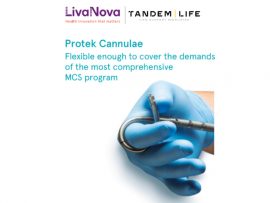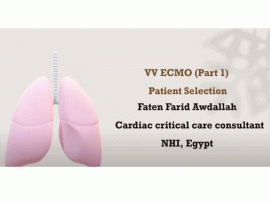Abstract Purpose To assess whether prone positioning (PP) increases bleeding risk compared to supine positioning in ARDS patients undergoing veno venous Extracorporeal Membrane Oxygenation (VV ECMO). Materials and Methods A..
Lee masAbstract Venovenous extracorporeal membrane oxygenation (VV ECMO) relies on effective blood drainage, and cannula design plays a crucial role in optimizing blood oxygenation. Recirculation, where oxygenated blood returns to the..
Lee masAbstract Purpose The optimal ventilation strategy in acute respiratory distress syndrome (ARDS) patients with veno-venous extracorporeal membrane oxygenation (VV-ECMO) remains unknown. We aimed to compare the effects of two ultra-protective..
Lee masAbstract Background Veno-venous extracorporeal membrane oxygenation (VV-ECMO) supports critically ill patients with respiratory failure. However, ECMO may induce systemic inflammation, hemolysis, and hemodilution, potentially resulting in endothelial activation and damage. Therefore,..
Lee masAbstract Objectives: To evaluate the safety and efficacy of venovenous extracorporeal membrane oxygenation (ECMO) cannulation by nonsurgeon intensivists (critical care medicine intensivists [CCM]) compared with cardiothoracic surgeons (CTS). Design: Retrospective,..
Lee masAbstract Background Thrombocytopenia is a recognized risk factor for bleeding during extracorporeal membrane oxygenation (ECMO). This study determines the incidence, risk factors, and clinical relevance of thrombocytopenia and platelet transfusions..
Lee masAbstract Background Veno‑venous extracorporeal membrane oxygenation (VV‑ECMO) is associated with a high transfusion burden. While trials have concluded that red blood cell (RBC) storage does not impact patient morbidity and..
Lee masAbstract Veno-venous extracorporeal membrane oxygenation (V-V ECMO) is a life support technique used for patients with life-threatening respiratory failure. It effectively addresses arterial hypoxemia without overstretching the injured lungs. Traditional..
Lee masAbstract Objective To evaluate the effectiveness of venovenous (VV) extracorporeal membrane oxygenation (ECMO) using a dual-lumen cannula coupled with continuous mechanical chest compressions (cMCC) for cardiopulmonary resuscitation and compare it..
Lee masAbstract Background: Data is limited regarding the effects of supraphysiologic blood oxygen tension (hyperoxia) in patients requiring extracorporeal life support (ECLS). We sought to evaluate the association between hyperoxia and..
Lee masAbstract Thyroid storm (TS) is an endocrine emergency requiring aggressive medical management. In severe cases, hemodynamic instability may necessitate extracorporeal membrane oxygenation (ECMO) support as a bridge to definitive surgical..
Lee masAbstract Rationale: Life-threatening airway obstructions caused by tumors demand prompt and effective intervention. Traditional surgical methods are often complicated by bleeding risks, especially with the use of anticoagulation during extracorporeal..
Lee masAbstract Microbiome analysis using metagenomics next-generation sequencing (mNGS) is rarely performed in patients receiving extracorporeal membrane oxygenation (ECMO). Patient body sites were swabbed within 72 hours of ECMO cannulation and..
Lee masAbstract BACKGROUND Veno-venous extracorporeal membrane oxygenation (V-V ECMO) is a lifesaving intervention for severe respiratory failure; however, its effectiveness depends on accurate cannulation-patients with anatomical variations present with significant challenges..
Lee masAbstract Background Veno‑venous extracorporeal membrane oxygenation (VV‑ECMO) is associated with a high transfusion burden. While trials have concluded that red blood cell (RBC) storage does not impact patient morbidity and..
Lee masAbstract Purpose The evidence supporting the benefit on clinical outcomes of prone positioning during veno-venous extracorporeal membrane oxygenation (V-V ECMO) for acute hypoxemic respiratory failure remains inconclusive. We aimed to..
Lee masAbstract In neonates with pulmonary hypertension (PH) supported on veno-venous extracorporeal membrane oxygenation (VV-ECMO), keeping the ductus arteriosus (DA) open ensures a high cardiac output of well-oxygenated blood through the..
Lee masAbstract OBJECTIVES Although lung transplantation has experienced great development in the past decades, the survival rate remains low, and lung ischaemia–reperfusion injury during transplantation is a major cause of primary..
Lee masAbstract Necrotizing pneumonia is a severe complication of bacterial or viral pneumonia that can lead to refractory respiratory failure in children. Extracorporeal membrane oxygenation (ECMO) has emerged as a vital..
Lee masAbstract Background Coagulopathy frequently complicates venovenous extracorporeal membrane oxygenation (VV ECMO) procedures, yet its underlying mechanism remains elusive. This retrospective study aimed to identify factors contributing to coagulopathy during VV..
Lee masFaten Farid Awdallah: [gallery ids="49616"] Critical care consultants at king Abdullah medical city, holly capital. Critical care ass professor at national heart institute, Egypt
Lee masAbstract Venopulmonary arterial (VPA) extracorporeal membrane oxygenation (ECMO) is emerging as an alternative to traditional venovenous (VV) ECMO for respiratory failure. This study compares rates of hemolysis and acute kidney..
Lee masAbstract Although venovenous (VV) extracorporeal membrane oxygenation (ECMO) is a life-saving intervention for trauma patients with severe respiratory failure, its mortality rate is 27%, and optimal metabolic markers for its..
Lee masAbstract Purpose Veno-venous extracorporeal membrane oxygenation (VV-ECMO) is increasingly being used in patients with respiratory failure. The goal of this study was to characterize postdischarge psychological and functional outcomes of..
Lee masAbstract This study investigated factors influencing recirculation in veno-venous extracorporeal membrane oxygenation (VV ECMO) using a controlled bench model comprising a VV ECMO circuit and a mock circulatory loop with..
Lee masAbstract We report the case of a 54-year-old man with right-lung pneumonia and contralateral pulmonary embolism (PE) conditioning severe refractory hypoxemia requiring veno-venous extracorporeal membrane oxygenation. Electrical impedance tomography (EIT)..
Lee masAbstract Although venovenous (VV) extracorporeal membrane oxygenation (ECMO) is a life-saving intervention for trauma patients with severe respiratory failure, its mortality rate is 27%, and optimal metabolic markers for its..
Lee masAbstract Purpose: The evidence supporting the benefit on clinical outcomes of prone positioning during veno-venous extracorporeal membrane oxygenation (V-V ECMO) for acute hypoxemic respiratory failure remains inconclusive. We aimed to..
Lee masAbstract Background: We evaluated the impact of noninvasive respiratory support (NRS) and invasive mechanical ventilation duration before venovenous extracorporeal membrane oxygenation (VV-ECMO) on weaning from venovenous ECMO and survival. Methods: In..
Lee masAbstract Background Hemolysis is a common complication in critically ill patients with sepsis, acute respiratory distress syndrome (ARDS) or therapy with extracorporeal membrane oxygenation (ECMO). Heme degradation product bilirubin might..
Lee mas
















